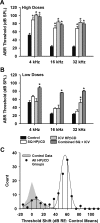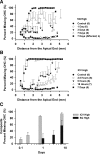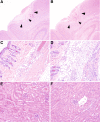Hearing Loss and Otopathology Following Systemic and Intracerebroventricular Delivery of 2-Hydroxypropyl-Beta-Cyclodextrin
- PMID: 26055150
- PMCID: PMC4569609
- DOI: 10.1007/s10162-015-0528-6
Hearing Loss and Otopathology Following Systemic and Intracerebroventricular Delivery of 2-Hydroxypropyl-Beta-Cyclodextrin
Abstract
Cyclodextrins are simple yet powerful molecules widely used in medicinal formulations and industry for their ability to stabilize and solubilize guest compounds. However, recent evidence shows that 2-hydroxypropyl-β-cyclodextrin (HPβCD) causes severe hearing loss in mice, selectively killing outer hair cells (OHC) within 1 week of subcutaneous drug treatment. In the current study, the impact of HPβCD on auditory physiology and pathology was explored further as a function of time and route of administration. When administered subcutaneously or directly into cerebrospinal fluid, single injections of HPβCD caused up to 60 dB threshold shifts and widespread OHC loss in a dose-dependent manner. Combined dosing caused no greater deficit, suggesting a common mode of action. After drug treatment, OHC loss progressed over time, beginning in the base and extending toward the apex, creating a sharp transition between normal and damaged regions of the cochlea. Administration into cerebrospinal fluid caused rapid ototoxicity when compared to subcutaneous delivery. Despite the devastating effect on the cochlea, HPβCD was relatively safe to other peripheral and central organ systems; specifically, it had no notable nephrotoxicity in contrast to other ototoxic compounds like aminoglycosides and platinum-based drugs. As cyclodextrins find expanding medicinal applications, caution should be exercised as these drugs possess a unique, poorly understood, ototoxic mechanism.
Keywords: cochlea; cyclodextrin; drug delivery; hearing loss; ototoxicity.
Figures






References
-
- Ahsan F, Arnold JJ, Yang T, Meezan E, Schwiebert EM, Pillion DJ. Effects of the permeability enhancers, tetradecylmaltoside and dimethyl-beta-cyclodextrin, on insulin movement across human bronchial epithelial cells (16HBE14o-) Eur J Pharm Sci. 2003;20:27–34. doi: 10.1016/S0928-0987(03)00163-5. - DOI - PubMed
-
- Casas E, Barron C, Francis SA, McCormack JM, McCarthy KM, Schneeberger EE, Lynch RD. Cholesterol efflux stimulates metalloproteinase-mediated cleavage of occludin and release of extracellular membrane particles containing its C-terminal fragments. Exp Cell Res. 2010;316:353–365. doi: 10.1016/j.yexcr.2009.10.020. - DOI - PMC - PubMed
Publication types
MeSH terms
Substances
Grants and funding
LinkOut - more resources
Full Text Sources
Other Literature Sources
Research Materials
Miscellaneous

